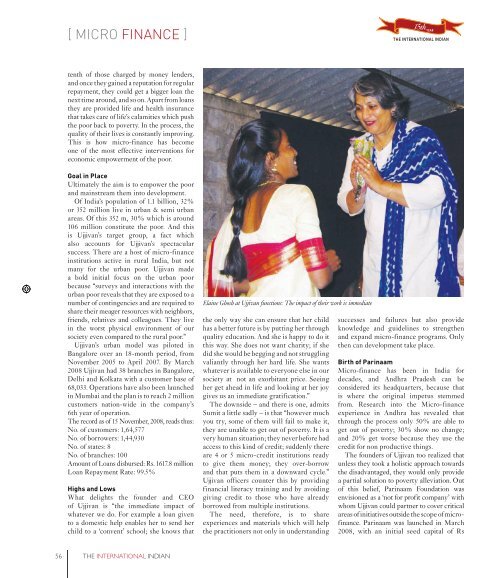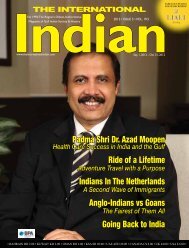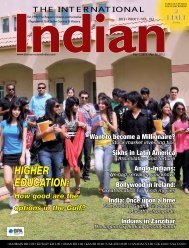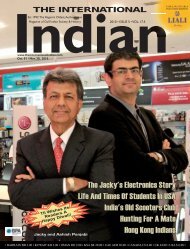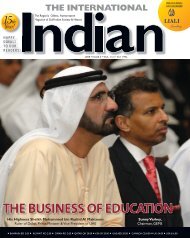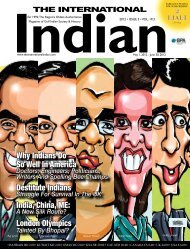THE INTERNATIONAL - International Indian
THE INTERNATIONAL - International Indian
THE INTERNATIONAL - International Indian
Create successful ePaper yourself
Turn your PDF publications into a flip-book with our unique Google optimized e-Paper software.
[ MICRO FINANCE ]<br />
tenth of those charged by money lenders,<br />
and once they gained a reputation for regular<br />
repayment, they could get a bigger loan the<br />
next time around, and so on. Apart from loans<br />
they are provided life and health insurance<br />
that takes care of life’s calamities which push<br />
the poor back to poverty. In the process, the<br />
quality of their lives is constantly improving.<br />
This is how micro-finance has become<br />
one of the most effective interventions for<br />
economic empowerment of the poor.<br />
Goal in Place<br />
Ultimately the aim is to empower the poor<br />
and mainstream them into development.<br />
Of India’s population of 1.1 billion, 32%<br />
or 352 million live in urban & semi urban<br />
areas. Of this 352 m, 30% which is around<br />
106 million constitute the poor. And this<br />
is Ujjivan’s target group, a fact which<br />
also accounts for Ujjivan’s spectacular<br />
success. There are a host of micro-finance<br />
institutions active in rural India, but not<br />
many for the urban poor. Ujjivan made<br />
a bold initial focus on the urban poor<br />
because “surveys and interactions with the<br />
urban poor reveals that they are exposed to a<br />
number of contingencies and are required to<br />
share their meager resources with neighbors,<br />
friends, relatives and colleagues. They live<br />
in the worst physical environment of our<br />
society even compared to the rural poor.”<br />
Ujjivan’s urban model was piloted in<br />
Bangalore over an 18-month period, from<br />
November 2005 to April 2007. By March<br />
2008 Ujjivan had 38 branches in Bangalore,<br />
Delhi and Kolkata with a customer base of<br />
68,033. Operations have also been launched<br />
in Mumbai and the plan is to reach 2 million<br />
customers nation-wide in the company’s<br />
6th year of operation.<br />
The record as of 15 November, 2008, reads thus:<br />
No. of customers: 1,64,577<br />
No. of borrowers: 1,44,930<br />
No. of states: 8<br />
No. of branches: 100<br />
Amount of Loans disbursed: Rs. 1617.8 million<br />
Loan Repayment Rate: 99.5%<br />
Highs and Lows<br />
What delights the founder and CEO<br />
of Ujjivan is “the immediate impact of<br />
whatever we do. For example a loan given<br />
to a domestic help enables her to send her<br />
child to a ‘convent’ school; she knows that<br />
Elaine Ghosh at Ujjivan functions: The impact of their work is immediate<br />
the only way she can ensure that her child<br />
has a better future is by putting her through<br />
quality education. And she is happy to do it<br />
this way. She does not want charity; if she<br />
did she would be begging and not struggling<br />
valiantly through her hard life. She wants<br />
whatever is available to everyone else in our<br />
society at not an exorbitant price. Seeing<br />
her get ahead in life and looking at her joy<br />
gives us an immediate gratification.”<br />
The downside – and there is one, admits<br />
Sumit a little sadly – is that “however much<br />
you try, some of them will fail to make it,<br />
they are unable to get out of poverty. It is a<br />
very human situation; they never before had<br />
access to this kind of credit; suddenly there<br />
are 4 or 5 micro-credit institutions ready<br />
to give them money; they over-borrow<br />
and that puts them in a downward cycle.”<br />
Ujjivan officers counter this by providing<br />
financial literacy training and by avoiding<br />
giving credit to those who have already<br />
borrowed from multiple institutions.<br />
The need, therefore, is to share<br />
experiences and materials which will help<br />
the practitioners not only in understanding<br />
successes and failures but also provide<br />
knowledge and guidelines to strengthen<br />
and expand micro-finance programs. Only<br />
then can development take place.<br />
Birth of Parinaam<br />
Micro-finance has been in India for<br />
decades, and Andhra Pradesh can be<br />
considered its headquarters, because that<br />
is where the original impetus stemmed<br />
from. Research into the Micro-finance<br />
experience in Andhra has revealed that<br />
through the process only 50% are able to<br />
get out of poverty; 30% show no change;<br />
and 20% get worse because they use the<br />
credit for non productive things.<br />
The founders of Ujjivan too realized that<br />
unless they took a holistic approach towards<br />
the disadvantaged, they would only provide<br />
a partial solution to poverty alleviation. Out<br />
of this belief, Parinaam Foundation was<br />
envisioned as a ‘not for profit company’ with<br />
whom Ujjivan could partner to cover critical<br />
areas of initiatives outside the scope of microfinance.<br />
Parinaam was launched in March<br />
2008, with an initial seed capital of Rs<br />
56<br />
<strong>THE</strong> <strong>INTERNATIONAL</strong> INDIAN


